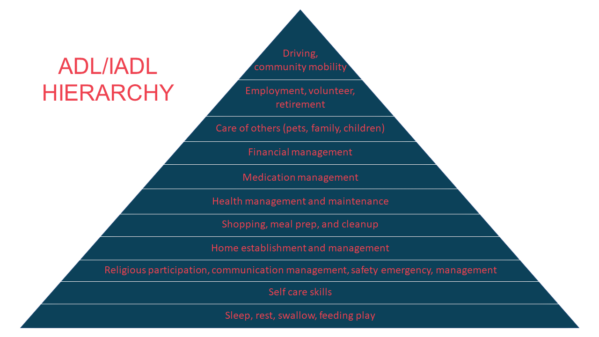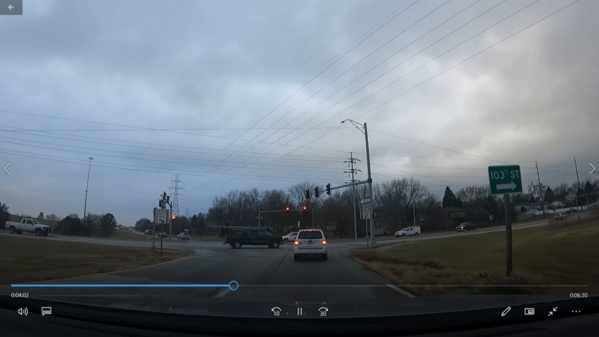As therapists, one of the most common goals our clients have is to return to driving. It offers the opportunity to access the community, a jobsite, leisure activities, and an overwhelming sense of independence often lost after illness or injury.
However, returning to driving is an extensive process and certainly not one that should be rushed. After an injury, physical and/or cognitive changes can impact performance. These changes take time to address and heal, and without time to recover and the appropriate amount of rehabilitation, there is a higher chance of failure which could lead to further injury.
The skills needed to drive fall at the top of the ADL/IADL hierarchy as seen in the figure below. Not only does driving require physical skill and coordination, but also it incorporates the visual system, vestibular function, cognitive and decision-making abilities and reaction time. Driving is inherently dangerous without any of these areas being diminished due to illness or injury, and as you might expect, the safety risks increase greatly when there are deficits in these areas.
Consider the Hierarchy
Similar to the way we interpret Abraham Maslow’s hierarchy of needs, the aspects of one’s life lower down in the ADL/IADL hierarchy must be satisfied before being able to attend to those at the top. This is not to say this is an “all-or-nothing” scenario where each level of the hierarchy must be 100% satisfied to move onto the next. Instead, when aspects at the bottom of the hierarchy are “more or less satisfied,” there is a natural transition to the next level.
The hierarchy is not necessarily linear either. The order of importance may vary depending on external circumstances or individual differences. For example, some individuals may value shopping and meal prep over the need for independence with home establishment and management.
These factors could also be influenced by a shift in role compared to pre-injury. For instance, responsibility for the finances prior to the injury may be transferred from one spouse to another in exchange for care of others, shopping, meal prep, etc. This shift is often dictated by physical and/or cognitive abilities.

(Davin et al., 2020.)
In any event, given that driving is at the top of this hierarchy, there are many aspects of one’s life that need to be in order before first. Working with a skilled therapist to evaluate physical and cognitive ability helps determine one’s readiness and is imperative to a safe and successful behind-the-wheel experience. These therapists are not only trained in adaptations and modifications needed to return to drive, but also in the identification and treatment of cognitive and visual skills needed to return to driving in a safe manner.
When going through driver’s rehabilitation, it is important to do this in-person, as the therapist will evaluate and treat skills needed for safe driving, and it should be done prior to completing the behind-the-wheel portion of the evaluation.
The Impact of Virtual Occupational Therapy
So where does the role of the virtual therapist fit into this?
Virtual Occupational Therapists (OT’s) are equipped to perform the same clinical pre-tests utilized during in-person assessment/training to determine any deficits prior to scheduling a formal driver’s rehabilitation evaluation. Not only are they equally effective, but also this approach allows access to experts who specialize in driver’s training and offers additional convenience by eliminating the need to drive to a clinic. Specifically, assessments related to vision, cognitive abilities, and physical access are possible.
Vision screening helps to identify if visual deficits are present, and they can be treated with a home exercise program lead virtually by an OT to improve functional vision as well as visual perceptual skills. This is important as it allows for adequate processing of all visual information while driving, which then contributes to decision making.
Pre-filmed on-the-road videos can be helpful in assessing and/or treating cognitive processing, attention, and decision making. Below is a still photo from an actual drive that can be utilized during a therapy session. This challenges the visual system, and depending upon the instructions given, it provides information on processing speed, divided attention abilities, memory recall, and general knowledge of rules of the road. Videos are also utilized to increase visual tolerance and gradual introduce more and more stimuli similar to what someone would experience during driving.

Virtual OTs can also complete a stationary screen to assess physical abilities and control prior to having them meet with a specialist in person. This includes the physical transfer to/from the vehicle, evaluation of the ability to move the right foot between gas and brake, physical endurance to complete that movement for a period of time, evaluation of sensation and proprioception for sustained pressure on the gas pedal, and coordination of upper extremities on the wheel. While each of these skills are observed in an unmoving vehicle, they are great tools for therapeutic treatment to prepare the client for an upcoming evaluation. If deficits are present, virtual OT’s are able to develop and implement treatment plans to promote improvement in these areas.
Virtual Occupational Therapy services are in no way a replacement for in person OT evaluation for return to driving. However, because driving is often a top motivator for clients, access to treatment prior to an evaluation is not only convenient with this approach, but it can also help to ensure readiness for in-person rehabilitation before getting behind the wheel.
If you’re curious about returning to driving or feel that you are ready to be evaluated, discuss with your primary MD to get a referral to see a Driver’s Rehabilitation Specialist.
For more information on virtual OT services specific to driving, contact Kintinu.
References:
Davin, J., Klein-Erdman, D., & Kadam, M. (2020, July 26-28). Navigating driver rehab with language deficits post stroke: Case example guide to evaluating driving with aphasia [Conference session.] ADED 2020 Conference.





